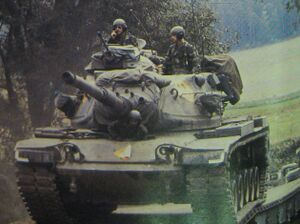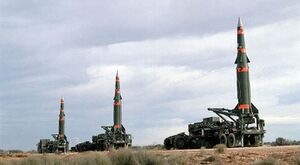Third Axiom War: Difference between revisions
(Created page with "{{Template:WIP}} Category:Wars Category:South Axiom The Third Axiom War was a ten month-long conflict from May to August 1984 between the [[Federation of South Axiom]...") |
No edit summary |
||
| Line 28: | Line 28: | ||
| combatant1 = {{plainlist | | | combatant1 = {{plainlist | | ||
* South Axiom | * South Axiom | ||
---- | |||
'''Multi-national Force''' | |||
* United States | * United States | ||
* United Kingdom | * United Kingdom | ||
* | * Canada | ||
* Italy | |||
* Australia | |||
* South Korea | |||
* Turkey | |||
* France | |||
* New Zealand | |||
* Greece | |||
* Belgium | |||
* Netherlands | |||
* Philippines | |||
{{Collapsible list | |||
| bullets = yes | |||
| title = Medical/Logistics Support | |||
| West Germany | |||
| Japan | |||
| Denmark | |||
| Israel | |||
| Norway | |||
| Sweden | |||
| Taiwan | |||
| Spain | |||
| Luxembourg | |||
| Mexico | |||
}} | |||
}} | }} | ||
| combatant2 = {{plainlist | | | combatant2 = {{plainlist | | ||
| Line 45: | Line 71: | ||
| units3 = | | units3 = | ||
| strength1 = {{plainlist | | | strength1 = {{plainlist | | ||
* 1, | South Axiom | ||
* 3, | * 1,030,000 active troops | ||
* 6, | * 790,000 reserve troops | ||
* 1,900 artillery units | * 3,800 tanks | ||
* 1, | * 6,500 armored carriers | ||
* 2,300 artillery units | |||
* 1,800 combat aircraft | |||
* 260 warships | |||
---- | |||
{{Collapsible list | |||
| bullets = yes | |||
| title = Multi-national Force | |||
| United States | |||
* 465,000 troops | |||
* 1,300 tanks | |||
* 2,400 armored carriers | |||
* 900 artillery units | |||
* 1,400 combat aircraft | |||
* 190 warships | |||
| United Kingdom | |||
}} | |||
}} | }} | ||
| strength2 = {{plainlist | | | strength2 = {{plainlist | | ||
* 1, | People's Republic of Axiom | ||
* 3, | * 1,860,000 active troops | ||
* | * 3,240,000 reserve troops | ||
* | * 7,300 tanks | ||
* | * 10,600 armored carriers | ||
* 4,200 artillery units | |||
* 2,300 combat aircraft | |||
* 320 warships | |||
---- | |||
Soviet Union | |||
}} | }} | ||
| strength3 = | | strength3 = | ||
| casualties1 = | | casualties1 = | ||
| casualties2 = 413,982 military | South Axiom | ||
* 185,597 military KIA/MIA | |||
* 329,365 civilian dead | |||
* 739,453 wounded | |||
* 13,504 POW | |||
---- | |||
United States | |||
* 45,387 military KIA/MIA | |||
* 124,605 wounded | |||
* 3,407 POW | |||
---- | |||
United Kingdom | |||
* 1,476 military KIA/MIA | |||
* 4,528 wounded | |||
* 198 POW | |||
| casualties2 = | |||
People's Republic of Axiom | |||
* 413,982 military KIA/MIA | |||
* 364,453 civilian dead | |||
* 1,042,064 wounded | |||
* 193,165 POW | |||
Soviet Union | |||
* 1,405 military dead | |||
* 3,186 wounded | |||
* 213 POW | |||
Other Warsaw Pact | |||
* 563 military dead | |||
* 1,046 wounded | |||
* 95 POW | |||
| casualties3 = | | casualties3 = | ||
| notes = | | notes = | ||
Revision as of 05:46, 1 April 2019
This article is incomplete because it is pending further input from participants, or it is a work-in-progress by one author. Please comment on this article's talk page to share your input, comments and questions. Note: To contribute to this article, you may need to seek help from the author(s) of this page. |
The Third Axiom War was a ten month-long conflict from May to August 1984 between the Federation of South Axiom and the People's Republic of Axiom. It was the last full-scale conflict to occur between major powers, and the second conflict in world history where nuclear weapons were used in anger.
The war began with a surprise offensive against the South Axiomian border provinces of Wralod, Istalar, North Skale, Sovyl and Balagur by the People's Army of Axiom. South Axiom ordered a general mobilization of all available reserves, and an emergency meeting of NATO leaders and commanders invoked Article 5 of the NATO treaty against the People's Republic of Axiom. Despite mainly being a conflict between South Axiom and the PRX, the Third Axiom war also saw extensive direct and indirect support for both countries from NATO and Warsaw Pact nations.
After months of heavy conventional warfare, including the Fall of Kesra, the Battle of Solkar Ridge, the Liberation of Ralis and the Fondor Landings, the PRX forces were pushed back to Lazar, Draxis, South Marat and Qaldur. The air, naval and technological superiority enjoyed by South Axiom and its NATO allies proved vital in turning the tide. The Battle of Kasgar Plains in April 1982 resulted in the encirclement and destruction of an entire PRX armored corps, and was the final large battle of the war, However, the PRX resorted to tactical nuclear weapons to stop the advancing RXA and RXMC divisions, leading to a limited South Axiomian nuclear strike against PRX military installations.
| Third Axiom War | |||||||
|---|---|---|---|---|---|---|---|
| Part of Cold War | |||||||
Advancing South Axiom TX-1 Sabre-cat Tank near Ralis, Istalar | |||||||
| |||||||
| Belligerents | |||||||
Multi-national Force
Medical/Logistics Support
|
| ||||||
| Strength | |||||||
|
South Axiom
Multi-national Force
|
People's Republic of Axiom
Soviet Union | ||||||
| Casualties and losses | |||||||
|
South Axiom
United States
United Kingdom
|
People's Republic of Axiom
Soviet Union
Other Warsaw Pact
| ||||||
Lead up to War
Since the Second Axiom War thirty years earlier, relations between the Federation of South Axiom and the People's Republic of Axiom had always remained hostile. This was exacerbated by the PRX's development of nuclear weapons in 1970, and the wider Cold War in Europe and the world. Border incidents, military exercises and airspace incursions were common during the 1960s and 1970s. Even during the detente era of the 1970s, the Axiom subcontinent still maintained heightened military readiness. Throughout these three decades an arms race between the two powers had led to the deployment of countless new weapons systems, from tanks and artillery to aircraft and warships.
The start of the 1980s saw the end of detente between the United States and the Soviet Union. The elections of conservatives such as Reagan in the US and Thatcher in the UK signaled a return to the East-West rivalry. The Soviet invasion of Afghanistan and the Intermediate Nuclear Forces issue were just two of a growing list of clashes between the capitalist and communist camps. The Able Archer crisis, the shooting down of KAL 007 and the Soviet nuclear false alarm of 1983 all placed the two sides dangerously close to conflict.
The People's Republic of Axiom had concerns that its numerical superiority in air and land forces was being steadily neutralized by the technological, economic and naval edge of the Federation of South Axiom. In particular the road-mobile, 1,840 km range MXM-3 Viking MRBM, deployed in 1982, had the potential to carry out a highly accurate first strike on PRX nuclear and strategic assets.
From February 1984 the PRX Security Bureau (the XSB) started to closely monitor South Axiom forces and government agencies, looking for signs of an impending attack. In early May 1984, South Axiom conducted a civil evacuation drill, closely followed by a military readiness drill. The increased activity on official South Axiom channels and around military bases convinced the PRX leadership that a strike was imminent, and more than 1.7 million PRX troops were secretly readied for a preemptive assault.
The PRX Invasion
At 4:30 AM on May 17, 1984, the PRX Air Force launched a massive conventional air and missile strike on South Axiomian air bases. Meanwhile more than 20,000 paratroopers and special forces troops landed behind RXA lines, aiming to capture important transport links and military positions. They opened up paths for the main armored and mechanized divisions, with heavy concentrations of firepower driving back the RXA forces.
At sea, PRX nuclear and conventional attack submarines attacked RXN ships, sinking a destroyer, two frigates, several corvettes and numerous civilian cargo ships. PRX Naval Aviation bombers attacked the RXMS Golas carrier battle group with supersonic anti-ship missiles, damaging two escorts and the Golas. However, RXN air defenses and carrier air patrols managed to shoot down 8 out of the 14 attacking bombers. The PRX submarine forces also lost two diesel submarines against RXN ASW screens.
In the air and land battles, PRX divisions and air wings used the element of surprise to encircle RXA troops and destroy dozens of aircraft on the ground. In two weeks PRX armored spearheads penetrated up to 200 km into South Axiomian territory, but many RXA units and civilians manage to escape to friendly lines.

